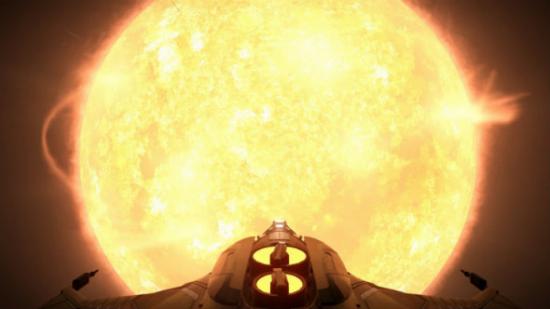This isn’t my first haul, though it’s definitely going to be the most dangerous. Trawling through the job postings at the morally bankrupt Robigo Station, I can’t believe my luck: a million credits to ferry some slaves across the galaxy. At ten jumps, it’s a risky trip, but well worth the payoff. Being a space games journalist, I abandoned ethics long ago.
Why not delve into our list of the best space games?
The first jump goes without a hitch, and I decelerate just in time to see the system’s star fill my ship’s canopy with its blinding glow. My hull’s temperature is rising, but I’m at a safe distance from the burning sphere, despite its intimidating size dwarfing my Cobra Mk III. Boosting away, I charge my frame-shift drive – ready to jump to the next system – and I shoot forward, stars trailing past me in neon streaks.
The next four jumps go by just as uneventfully, but then during the next – just as I try escape the pull of a red supergiant, luring me towards it like a metallic moth – a warning message pops up to tell me I’m being interdicted. Pulled out of supercruise by the interdiction, with my engines powered down, the pirate tells me to surrender my cargo.
So I open fire.
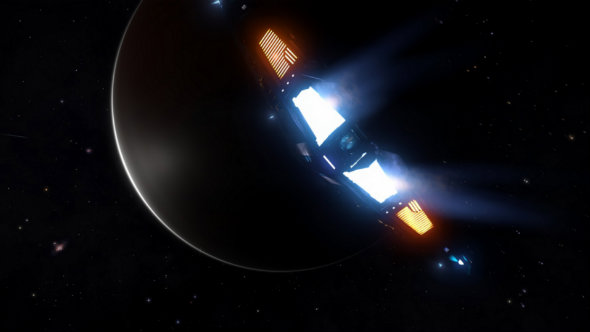
We’re like intergalactic dance partners, gliding past each other and trading shots. Thing is, I’m being outdanced. Luckily, I hold him off just long enough to power my FSD, so I divert power from my weapons and pump all the juice into my engines, boosting away from the incoming fire as I prepare to jump away.
Battered, bruised, and exhausted, I arrive at the target system, ready to turn in my human cargo. I just need to supercruise to the station and then sneak my way aboard without being scanned by the security forces there.
I’m interdicted again on my way – this time by a security ship who asks me to hold still for a scan. I pop some chaff to throw off its scanners and deploy my hardpoints, forcing it to deploy its own weapons. It’s just enough to buy me some time to retract my weapons, divert energy to engines and boost away in the confusion, charging my FSD and slipping back into supercruise.
Finally, my ship intact, I reach the station. Once within range, I request docking permission… Denied. All the bays are full.
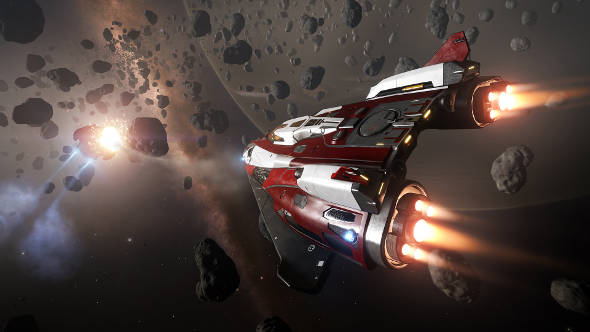
At any time, I could be scanned by the station’s security and, if they succeed, I’ll be fired upon and a bounty will be placed on my head – not that I will survive the incoming salvo. I request to dock again. This time it’s approved, so I make my approach to the letterbox opening at the rotating station’s waiting maw. Just then, my HUD picks up a scan from another security vessel, so I push my throttle forward and attempt to speed into the station, fines be damned. All I need to do is pull up at the last minute and sail into the opening inside like the smoothest mofo in the Milky Way.
I smash straight into the station’s hull. My human cargo, myself, my ship and all my dreams of being an Elite: Dangerous millionaire go up in flames. “Lol” pops up in the open chat window.
While maddening, this series of events during an Elite: Dangerous session seared into my memory, creating an unforgettable gaming experience that was purely driven by the game’s systems and my own choices within them. No Man’s Sky has a lot in common with Elite: Dangerous: both release you into the void of space and allow you to create your own objectives; both allow you to trade, fight in space battles or live your life as an intergalactic pirate; and both allow you to set your ship down on the surface of countless planets.
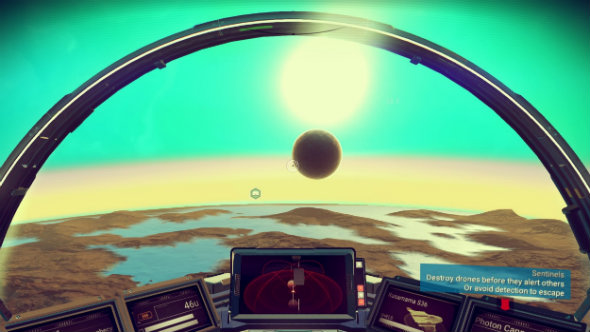
Elite: Dangerous currently only allows you to land on planets without an atmosphere, cruising around icy and rocky planets in your SRV buggy, mining rocks, attacking installations and using your boosters to glide safely down to the basin of giant canyons. Meanwhile, No Man’s Sky lets you explore on-foot and mine materials with a beam weapon, scanning flora and fauna for extra credits, taking shelter from the hostile elements on its randomly generate hellscapes, and admiring the verdant alien fields of its lush paradises.
On foot, No Man’s Sky has a clear advantage, on account of you not actually having feet in Elite (yet). As you progress through No Man’s Sky, however, the novelty of setting down onto its worlds begins to wear off, and you only begin to do so to mine the resources needed to craft fuel and make the next jump to another star system as you continue to chase icons across its galaxy map.
The only story No Man’s Sky can create is where you land on a planet and you can’t find the resources to take off again, so you have to trek across the planet’s surface for hours in pursuit of the right rock to shoot. That or you land your ship somewhere that you can’t reach with your jetpack, forcing you to hike across the planet for a trade platform where you can call your ship to your location. This is because Hello Games decided to let the game automate almost everythingthing remotely dangerous. You can die by being shot by a planet’s robotic sentinels, chewed by a rampaging carnivore, or blown up by attacking ships, but it’s rare and it’s also very unlikely you’ll die because of a tiny error.
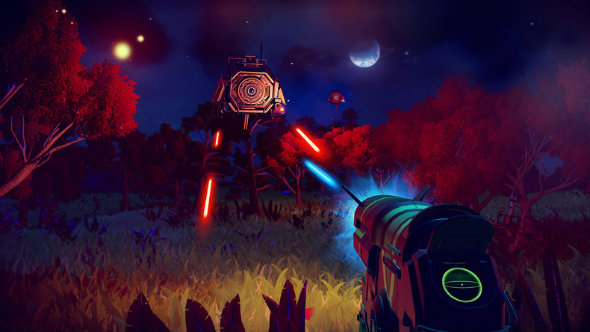
To reach a destination in No Man’s Sky, you hold a button and the game boosts you straight there via an autopilot. Stop, go and fire are your only methods of control. Entering a space station, the game steals control away from you as soon as you approach its mouth. You can even aim the nose of your ship at a planet and fly full speed at its crust, but the game will remove your control and pull your nose upwards. Even landing is automated and happens with the push of a button, taking away any feeling of accomplishment. You can, however, crash into an asteroid, but you just bounce off like a bumper car made entirely of rubber.
In Elite:Dangerous, every station approach is tense, whether you have a cargo hold full of humans or legal trade produce. Landing on planets feels different every time, thanks to different topography and distinct gravitational influences – the entire flight model changes as you approach Elite’s spheres. Try pulling off an aerial stunt on a high-G planet and you will drop like a brick.
It’s arguable that the two games serve different purposes, with Elite: Dangerous more a space sim, while No Man’s Sky is about galactic tourism. I’d argue that part of galactic tourism should be the danger, as it invests you more into the experience, immersing you more in its many worlds way better than any half-baked survival mechanics ever could. Nothing stops you appreciating the beauty of a primary-coloured solar system as bouncing off an asteroid, or flying towards the system’s star and realising it’s actually just painted on like a skybox, unreachable. These planets are orbiting no star. It’s all smoke and mirrors.
Frontier clearly have a much bigger team and more resources than Hello Games, but it just feels like the No Man’s Sky team could have learned a lot about player agency by spending some time with Elite: Dangerous. After all, No Man’s Sky might have 18 quintillion planets, but everything between them feels like empty space.
